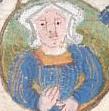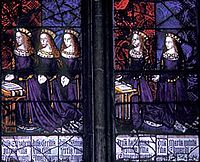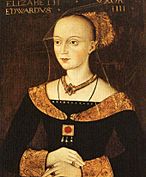Mary of York facts for kids
Quick facts for kids Mary of York |
|
|---|---|
 |
|
| Born | 11 August 1467 Windsor Castle, Berkshire, England |
| Died | 23 May 1482 (aged 14) Palace of Placentia, Greenwich, London, England |
| Burial | 28 May 1482 St George's Chapel, Windsor Castle |
| House | York |
| Father | Edward IV |
| Mother | Elizabeth Woodville |
Mary of York was a princess, born on August 11, 1467. She was the second daughter of King Edward IV of England and his wife, Queen Elizabeth Woodville. Mary lived during a time of big changes in England and sadly passed away on May 23, 1482, when she was only 14 years old.
Mary spent her early years with her older sister, Elizabeth of York. Elizabeth was about a year and a half older than Mary. The two princesses grew up together and learned about their religion. They often moved between the many royal homes. Sometimes, the girls would go to court for parties and important visits. They also had a strict daily schedule. Their safety was very important. It's interesting that there are almost no records of money spent on toys for them.
In 1469, Mary's father, King Edward IV, had a big disagreement. It was with a powerful supporter named the Earl of Warwick. Warwick joined forces with Mary's uncle, the Duke of Clarence. They also teamed up with the former Queen, Margaret of Anjou. Together, they started a rebellion against the King. Soon, Edward IV was removed from his throne. Mary, her mother, and her sisters found safety at Westminster Abbey. They stayed there for five months. Mary's younger brother, Edward, was born while they were hiding. His birth made the King want to get his kingdom back even faster. In April 1471, Edward IV took back London. He quickly moved his family from the Abbey to his mother's home. Then they moved to the Tower of London.
After Warwick's group was finally defeated, peace returned to England. People then started looking for husbands for Mary and her older sister. Elizabeth was planned to marry Dauphin Charles, who was the heir to the French throne. Mary was meant to be a backup. If something happened to Elizabeth, Mary would marry the Dauphin instead. In 1481, a Danish prince named Frederick was considered for Mary. He was the Duke of Holstein and Schleswig. But while they were talking about the marriage, Mary became very sick and died.
Contents
Birth and Early Life as a Princess
Mary was born on August 11, 1467, at Windsor Castle. She was the second daughter of King Edward IV of England and Queen Elizabeth Woodville. Mary was the second of their ten children. She also had two older half-brothers. They were from her mother's first marriage to John Grey of Groby. Their names were Thomas and Richard Grey.
Mary's grandparents on her father's side were Richard of York, 3rd Duke of York and Cecily Neville. Her grandparents on her mother's side were Richard Woodville, 1st Earl Rivers and Jacquetta of Luxembourg. Mary was baptized soon after she was born. Important people like the Archbishop of Canterbury and Cardinal Thomas Bourchier were her godparents.
In 1467, the King gave his wife Sheen Palace in Surrey to use for her whole life. This is where the royal children were raised. It was a tradition for royal children to grow up away from London and the court. This was for their safety and health. Mary and her older sister Elizabeth (born February 11, 1466) grew up here. They had a governess named Lady Margaret Berners. Lady Margaret was paid a lot for her work.
At Sheen Palace, Mary and Elizabeth spent their baby and early childhood years. Besides their governess, the princesses had many servants. They also had a large amount of money each year for their needs. The princesses also traveled a lot from a young age. The King and Queen, with their children and many people from court, moved between many royal homes. Most of these homes were in the Thames valley.
Royal Education and Court Life
Royal children began learning about religion very early. By the age of four, they were expected to know the psalter, a book of religious songs. Special days like Presentation of the Lord, Easter, Saint George's Day, Trinity, All Saints' Day, and Nativity of Christ were important. These days had special church services, sermons, and fun activities. Elizabeth and Mary would give offerings during Mass on these days.
On Maundy Thursday, the girls gave gifts to poor people. On Good Friday, they were taught to crawl on their knees to the cross. During Great Lent and Advent, the girls had to fast or not eat meat. On New Year's Eve, the princesses received gifts. On Twelfth Night, they could join in the celebrations and feasts.
Sometimes, the young princesses were called to the royal court. There, they attended festivals and important visits from other countries. At court, Elizabeth and Mary joined their mother's group of ladies. They learned good manners, music, singing, dancing, and embroidery. They learned everything needed to become future queens or wives of kings. They also learned how to be "decorations of the court." The girls wore small versions of the fancy clothes noble ladies wore. As they got older, they learned to handle heavy fabrics, long dresses, and fancy hats. Princesses were taught good manners from a young age. They were raised to deeply respect their parents, whom they did not see very often. Every night, they were together.
A Princess's Daily Schedule
Mary and Elizabeth likely followed a daily routine similar to their brother Edward's. The King set his routine when he was three years old. It might also have been based on the rules from their uncle George, the Duke of Clarence. The children woke up around six in the morning. This was so they could "get up at a convenient hour" for morning prayers in their bedroom.
Then a bell would ring, telling them it was time for Mass. The house chaplain led Mass in the local chapel. It was important for royal children to attend church services regularly. Right after Mass, the princesses ate breakfast. Breakfast probably included bread, butter, ale, fish, meat, or eggs. Dinner was served to the princesses at ten or eleven in the morning. This meal was a "noble service" of dishes. Important people and squires in uniforms brought the food. The meal could last up to two hours.
While they ate, the sisters listened to stories that taught good lessons. King Edward IV also insisted that all talks around them should be "virtuous, honest ... and wise." After dinner, the princesses would take a bath and maybe have an afternoon nap. Later, they would have drinks and bread. Then a bell called everyone to Vespers, an evening prayer. Dinner was served at four in the evening. The rest of the evening was spent playing games and listening to music. The King's daughters went to bed around eight in the evening. Before bed, they had a snack of bread, ale or wine, and other foods. It's interesting that records from this time hardly mention any toys for the princesses.
The safety of the princesses was very important. After Mary and Elizabeth's bedroom doors were locked at eight in the evening, only their personal servants could enter. At night, a burning candle or torch was left in their room. The outer gates were locked at nine in the evening in winter and ten in summer. Guards walked around the castle grounds three or four times a night. They checked every room. Later, a special person stayed in Prince Edward's room at night. This person watched over his safety and health. The princesses probably had someone like this too.
Difficult Times: 1469–1471
On March 20, 1469, the Queen had another daughter, Cecily. This worried the King. He thought his oldest daughter Elizabeth might rule the country after him. A year before, rumors spread about growing anger between the King's supporter, the Earl of Warwick, and the Queen. The Queen's many relatives were taking Warwick's place at court. In 1468, Edward IV and Warwick had a final falling out. This was over the marriage of the King's sister Margaret. Warwick wanted Margaret to marry a French prince to make an alliance with France. But Edward IV, following his wife's family's advice, married his sister to Charles, Duke of Burgundy. Charles was an enemy of France, and Warwick hated him.
In 1469, the fight between Warwick and the royal couple led to an alliance. Warwick joined with the King's younger brother, George, Duke of Clarence. Clarence's position as heir to the throne was threatened. This was because Edward IV thought about making his oldest daughter his successor.
Earlier, Warwick wanted his daughters Isabella and Anne to marry the King's brothers. His daughters were the richest heiresses in England. But Edward IV refused, fearing the Neville family would become too powerful. In July 1469, Clarence openly went against his brother. He married Warwick's oldest daughter in Calais. Then, both of them landed in England with soldiers. They said George should be King. They claimed Edward IV was not a true king.
At this time, Mary's mother, with at least two daughters, visited Norwich. They were welcomed with big parties and plays. It's not certain which of the two younger princesses was with her mother. But it was probably Mary, as Cecily was too young. The Queen and princesses stayed in the house of monk-preachers. Here, the royal family heard bad news. Warwick had won the Battle of Edgcote. He had also captured the King. And he had executed Mary's grandfather and uncle without a trial. It's not known how her grandfather's death affected the little princesses. But the Queen likely hid what happened from the children. At the same time, Mary's grandmother, Jacquetta of Luxembourg, was arrested. She was falsely accused of using magic spells on the King. Even though Jacquetta was found innocent, this event showed how far Edward IV's enemies would go. They wanted to harm his wife and her family. Despite this, the Queen and her daughters were not hurt during Warwick's short time in power. Only Mary's mother had fewer servants.
By the autumn of 1469, Edward IV managed to escape. In September, he entered London in triumph. He began to get nobles back on his side. In the winter of 1470, the King was fully in charge again. He declared Warwick and Clarence traitors. Both of them fled to France. By July 1470, Warwick made an alliance with the former Queen Margaret of Anjou. She wanted to put her husband or son back on the throne. As part of this alliance, the former Prince of Wales married Warwick's second daughter. In September 1470, Edward IV prepared for an invasion. Warwick and Margaret of Anjou's forces were coming. Mary, her sisters, and her mother were moved to the Tower of London for safety. The Queen ordered the Tower to be made stronger and security increased. Elizabeth Woodville was seven months pregnant. A place was ready for her to give birth. But she couldn't use it. Warwick invaded England. In early October, news came to London. Mary's father, with his younger brother Richard, Duke of Gloucester, had fled the country. They had little hope of returning. On October 6, Warwick and Clarence entered the City of London. On October 30, King Henry VI was officially made King again.
When Queen Elizabeth heard her husband had fallen from power, she quickly left the Tower. She left in the middle of the night on a boat. She went with her mother and three daughters, including Mary. They sought safety at Westminster Abbey. The Queen was known as a very religious woman there. When the royal family arrived, the Abbey was almost empty. The Abbot of Westminster, Thomas Milling, took them in. He was kind and welcoming. He didn't want to put the Queen and princesses with criminals. He gave them his house at the western entrance to the Abbey. It had three rooms and everything the royal family needed. Ordinary Londoners also helped them. A butcher named John Gould gave half a cow and two sheep each week. A fishmonger gave them food on Fridays and fasting days.
While hiding, the princesses spent most of their time with nannies. Queen Elizabeth was busy giving birth and caring for Prince Edward. He was born in early November 1470. Mary and her family stayed hidden for five more months. In April 1471, the princess's father returned to England. News of his son's birth encouraged him. First, he went to a thanksgiving service at Westminster Abbey. Then he took his family out of hiding. That same night, Mary and her family were taken to Baynard's Castle. This was her grandmother Cecily Neville's home. On April 11, the Queen and her children went to the Royal Apartments in the Tower of London. They were with the King's mother, the Queen's brother Anthony Woodville, and the Archbishop of Canterbury. Mary's father went north to get his crown back. On April 13, Warwick was killed at the Battle of Barnet. On May 4, Edward IV finally defeated the Lancastrian army at the Battle of Tewkesbury. The Lancastrian heir was killed, and Margaret of Anjou was captured. However, on May 12, while Edward IV was still traveling to London, the last supporters of the House of Lancaster attacked the Tower. They wanted to put Henry VI back on the throne. Two towers were fired upon from the river. Mary and her family were in one of them. The attack was stopped. But this made Edward IV decide to kill his predecessor. On May 21, 1471, Henry VI was killed in his prison cell.
Later Years and Death

In late 1474, King Edward IV was planning to invade France. He signed a will. It said that Mary and her older sister Elizabeth would each get a large sum of money. This was if they agreed to marry someone their mother and brother-King chose. However, only two months later, Edward IV made a peace treaty with France. One part of the treaty was that Mary's older sister would marry Dauphin Charles. He was the heir to the French throne. This would happen when she was old enough to marry. If Elizabeth died early, Mary would become the backup bride for the Dauphin.
However, in 1481, it seems Mary was promised to Frederick. He was the Duke of Holstein and Schleswig. He was the youngest son of King Christian I of Denmark. This meant France no longer needed a backup bride. Other sources say the engagement never happened. The marriage talks stopped soon after they began because the princess became very ill. Before this, Frederick's older brother, John, was also mentioned as a possible husband for Mary. But it's not known if any marriage talks ever started for him.
In 1476, Mary attended a special ceremony. It was for reburying her grandfather, the Duke of York, and his second son. In May 1480, Mary and her younger sister Cecily became Ladies of the Garter. This was a special honor. Their older sister Elizabeth had already become a Lady of the Garter earlier that year. There isn't much information about Mary's private life in her later years. Documents from that time mostly talk about the country's political situation.
In late 1481, Mary became sick. She died on May 23, 1482, at the Palace of Placentia. Her body was not embalmed. Instead, she was dressed in rich clothes. Her body was displayed for people to say goodbye in a church in Greenwich. On the same day, a special church service was held by the Bishop of Norwich James Goldwell. Another service was held the next day. Many religious leaders and nobles were there. Mary's coffin was taken in a grand procession to St George's Chapel at Windsor Castle. She was buried in the chapel's southeastern part. She was laid next to Prince George. He was the third son of Edward IV and Elizabeth Woodville, who died as a baby.
In 1789, a worker doing repairs in the chapel accidentally found and opened the tomb of King Edward IV and his wife. In a room next to their tomb, the coffins of two children were found. People thought they were George and Mary. However, in 1810, more burial places were being prepared in the chapel. These were for King George III's family. The remains of two more children were found in another room. Some of these remains were well preserved. They matched Mary's age. So, it is not fully known whose remains were buried next to the King and Queen.
See also
 In Spanish: María de York para niños
In Spanish: María de York para niños



